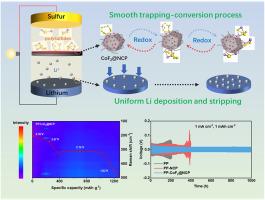CoF2纳米点嵌入n掺杂碳多面体作为无枝晶稳定锂硫电池的多功能中间层
IF 14.2
1区 材料科学
Q1 ENGINEERING, MULTIDISCIPLINARY
引用次数: 0
摘要
锂多硫化物(LiPSs)的穿梭效应和锂枝晶不受控制的生长仍然是锂硫(li -硫)电池大规模商业化的巨大障碍。为了同时解决这两个问题,在这里,我们首次提出了mof衍生的CoF2纳米点嵌入氮掺杂碳多面体(CoF2@NCP)作为多功能分隔层。导电NCP和原位生长的碳纳米管提供了高效的电子转移网络。最重要的是,均匀分布的极性亲锂CoF2纳米点不仅能强化学吸附和有效催化转化LiPSs,抑制穿梭效应,还能均匀调节锂离子通量,实现顺利剥离/镀,从而抑制枝晶生长。利用上述优点,含有CoF2@NCP的Li||Li对称电池可在1ma cm - 2下稳定循环1000 h,并在4ma cm - 2下保持稳定;含有CoF2@NCP的锂-s电池在0.2℃下的初始容量为1514.8 mA h g - 1,在150次循环后保持95.2 mA h g - 1,在4℃的高速率下显示出753.9 mA h g - 1的高容量。原位拉曼光谱和Li2S6吸附测试证实了有效的lips固定和加速氧化还原动力学。这项工作为设计无枝晶稳定锂电池的多功能中间层提供了一种合理的策略。本文章由计算机程序翻译,如有差异,请以英文原文为准。

CoF2 nanodots embedded N-doped carbon polyhedrons as a multifunctional interlayer for dendrite-free and stable lithium-sulfur batteries
The shuttle effect of lithium polysulfides (LiPSs) and the uncontrolled growth of lithium dendrites remain formidable barriers to the large-scale commercialization of lithium-sulfur (Li–S) batteries. In order to simultaneously address both issues, herein, for the first time, we present MOF-derived CoF2 nanodots embedded nitrogen-doped carbon polyhedrons (CoF2@NCP) as a multifunctional separator interlayer. The conductive NCP and in-situ grown CNTs provide efficient electron transfer network. Most importantly, the homogeneously distributed polar and lithiophilic CoF2 nanodots can not only strongly chemisorb and effectively catalytically convert LiPSs to suppress shuttle effect, but also uniformly regulate the Li-ion flux to realize smooth stripping/plating, thus inhibiting dendrite growth. Benefiting from the merits, the Li||Li symmetric cells with CoF2@NCP sustain stable cycling for 1000 h at 1 mA cm−2 and remain stable at 4 mA cm−2; the Li–S full cells with CoF2@NCP deliver an outstanding initial capacity of 1514.8 mA h g−1 at 0.2 C, retain 935.2 mA h g−1 after 150 cycles, and exhibit a high capacity of 753.9 mA h g−1 at a high rate of 4 C. In-situ Raman spectroscopy and Li2S6 adsorption tests confirm effective LiPSs immobilization and accelerated redox kinetics. This work offers a rational strategy for designing multifunctional interlayers for dendrite-free and stable Li–S batteries.
求助全文
通过发布文献求助,成功后即可免费获取论文全文。
去求助
来源期刊

Composites Part B: Engineering
工程技术-材料科学:复合
CiteScore
24.40
自引率
11.50%
发文量
784
审稿时长
21 days
期刊介绍:
Composites Part B: Engineering is a journal that publishes impactful research of high quality on composite materials. This research is supported by fundamental mechanics and materials science and engineering approaches. The targeted research can cover a wide range of length scales, ranging from nano to micro and meso, and even to the full product and structure level. The journal specifically focuses on engineering applications that involve high performance composites. These applications can range from low volume and high cost to high volume and low cost composite development.
The main goal of the journal is to provide a platform for the prompt publication of original and high quality research. The emphasis is on design, development, modeling, validation, and manufacturing of engineering details and concepts. The journal welcomes both basic research papers and proposals for review articles. Authors are encouraged to address challenges across various application areas. These areas include, but are not limited to, aerospace, automotive, and other surface transportation. The journal also covers energy-related applications, with a focus on renewable energy. Other application areas include infrastructure, off-shore and maritime projects, health care technology, and recreational products.
 求助内容:
求助内容: 应助结果提醒方式:
应助结果提醒方式:


